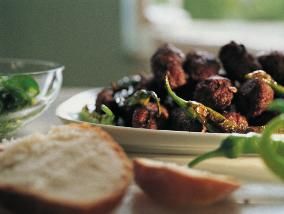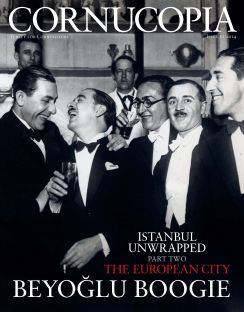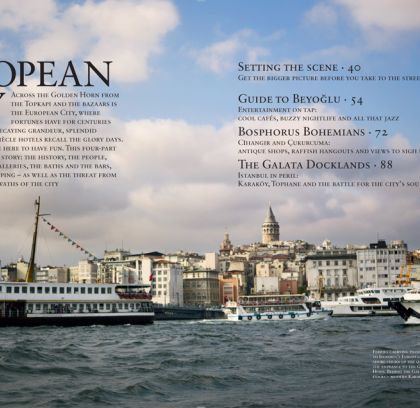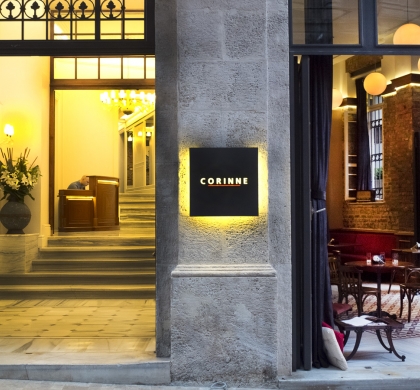Buy or gift a stand-alone digital subscription and get unlimited access to dozens of back issues for just £18.99 / $18.99 a year.
Please register at www.exacteditions.com/digital/cornucopia with your subscriber account number or contact subscriptions@cornucopia.net
Buy a digital subscription Go to the Digital EditionExcellent meatballs at this kitsch Çukurcuma institution, run by three generations of an ‘unusually tall family’. Perfect after a few hours of browsing the antique shops in the neighbourhood.
In Cornucopia 22, Berrin Torolsan gives her recipes for this beloved Turkish dish in ‘Meatball Wizard’.
Three köftes still stand out in my memory. Just thinking of them makes my taste buds ache. The first was in my early childhood: freshly grilled cızbız köfte, a round patty the size of a flattened walnut, so named because it makes a delicious “jiz-biz” sizzling sound as it cooks. There were two to a plate, with some salad or yoghurt and a slice of bread alongside. My mother remembers my insisting on eating the köfte first, then the bread, by itself. She used to tease me about having Tatar blood in my veins – my paternal grandfather was from the Crimea.
My second unforgettable köfte was in my student days, when I travelled down with friends to the Aegean for holidays. The bus stopped at Tekirdağ, on the shore of the Marmara. Next to the quay was a restaurant legendary for its potato croquettes. Patates köftesi are usually little round balls, nice but often stodgy. These ones were oblong and fried a deep golden colour. They were unbelievably light and deliciously croquant. Sun and sea have faded in the memory, but not that taste. How often I looked for the restaurant afterwards, never finding it. I fear it has vanished.
The third and last of those memorable köftes was some twenty years ago. I was working with an archaeological team in the arid southeast of Turkey. One day I was taken to the nearby town of Adıyaman for lunch. The drive from the camp was through an almost abstract, empty landscape of rolling orange hills, utterly treeless under the bluest of blue skies. The town was medieval; so was its single restaurant, in the marketplace, small, with a couple of tables spread with newspapers and wooden chairs. Along one wall was a charcoal brazier. The only item on the menu was kebab and I was the only female in the shop; I was a bit uneasy as we ordered. The meat in Ad›yaman in those days was invariably kid. Chopped to a fine mince studded with fat, it was skilfully kneaded and wrapped around a long flat skewer, with chunks of aubergine separating the two long patties. The skewers were left leaning against the brazier to cook. It didn’t take long, and when they arrived, the waiter elegantly slid them off the skewer on to my plate with a fork. The taste of those köfte kebabs is impossible to describe; it was quite simply out of this world. The meat was tender, with a deliciously chewy texture and no trace of fat, just a fragrant charred flavour, and the aubergines had turned into a creamy delight.
I have never eaten anything like it again. Shy and perhaps a little embarrassed by my urban squeamishness, I didn’t have the nerve to talk to the chef and find out more. Foolish of me.
So what is a köfte? The word has many variants: in Morocco kefta, in Bulgaria kyutfte, in Albania qufte, in Greece kefthe and in India kofta. The English tend to call it kofta, too. The origin of the word is the Persian koofteh, meaning pounded meat. Techniques, recipes and flavours may vary, but the main ingredient is usually minced meat. Sometimes lamb or veal is replaced by chicken, game or fish, or even pulses such as lentils, chickpeas or beans.
Before the invention of electric or even hand-powered mincing machines, meat was either pounded with pestles in special mortars, shaved with a razor-sharp blade, or chopped and minced with a large knife. The latter process is called k›ymak in Turkish (the same verb is used for chopping herbs). So important was the skill considered that there used to be a special guild for the k›ymac›lar, or mince-makers, as distinct from the butchers. Hand-minced meat has the advantage that it is unbruised and therefore retains its moisture. Mincers, by definition, grind the meat and diminish the quality of the mince. Food processors are better, so long as they are not used at too high a speed.
Mincing must be an ancient way of making use of the tough meat of newly slaughtered animals. Because the fibres are broken down, mince is an easily digested source of protein for young children, the elderly and anyone who lacks strong teeth. But it also goes off much more quickly than whole meat. A traditional way of preserving it is to fry it with salt in rendered fat. This kuru kıyma, or dry mince, can be stored for a long time, ready to be added to soups and stews whenever needed, to add flavour and substance. Like most Turkish women, I still keep some of this mince – which I cook in butter rather than rendered fat – in the fridge at all times. It can keep for a month.
Another way of preserving mince is to cure it by kneading salt and spices into it. The resulting mixture is squeezed into a clean casing of intestines to make sausages, which are then air-dried or smoked. At sausage-making time, it is still the custom in the countryside to grill little patties of the mixture for a quick tasting to check the seasoning – and to do the same with any filling left over after the casing is used up. The sausagemeat recipe Sucuk Köftesi below probably derives from this custom.
Mince that is not preserved in these ways and is for immediate consumption is mixed with salt, spices, crushed garlic, chopped onion and herbs and used for pasta dishes, as a pastry filling, and for stuffing various vegetables to make dolmas…
KADIN BUDU KÖFTE
Lady’s Thighs
500g minced meat
2 cups parsley (finely chopped)
1 cup cooked rice or leftovers of pilav
4 eggs
Salt
1 dessertspoon pepper (freshly ground)
1 dessertspoon cinnamon powder
Oil for frying
Who knows how this voluptuous köfte got such a sexy name? Sexy it might be, but it is also very easy to prepare, without even getting your hands oily. And it is even easier if you have some leftover rice pilav. Otherwise quickly cook half a cup of rice in a cup of salted cold water until the rice grains are soft and have absorbed all the water. There are many more complicated ways to prepare this köfte, but this is the most practical and the end result is rewarding.
1 In a large bowl, with a wooden spoon mix the meat, parsley, cooked rice, two eggs, salt, pepper and cinnamon until it is all smoothly blended.
2 Beat the two remaining eggs lightly with a fork and pour over the meat mixture, this time without mixing.
3 Heat the oil in a large frying pan. Take two tablespoons and use one to scoop up a good tablespoonful of the meat mixture and press the other on top, cupping the meat into shape.
4 Drop the köftes into hot oil, one after the other, and fry them crisp on both sides.
5 Serve hot or cold with plenty of salad or with natural yoghurt.
Other recipes in this article: Cızbız Köfte (Grilled Patties); Kuru Köfte (Fried Patties); Sahanda Köfte (Pan-Cooked Patties); Bulgur Köftesi (Bulgur Patties); Içli Köfte (Rissoles); Patates Köftesi (Potato Croquettes); Sikma Köfte (Meatballs with Half-Moon Onions); Sucuk Köftesi (Garlic Patties); Rulo Köfte (Meatloaf with Eggs); Balik Köftesi (Fish Croquettes)
Note on minced meat: If you want to buy mince, always ask your butcher to prepare it from a whole cut of meat. Ideally, make your own in a food processor from chops or steaks suitable for grilling. It will have a delicious chewy texture. Remove any bones and tough bits, but leave on the fat so that the meat does not become too dry. Chop it roughly into cubes with a sharp knife. Use the pulse switch of the food processor in short bursts; process the meat for a few seconds only, taking care not to purée it.






 Issue 66, December 2023
Turkey’s Centenary Issue
Issue 66, December 2023
Turkey’s Centenary Issue

Cornucopia works in partnership with the digital publishing platform Exact Editions to offer individual and institutional subscribers unlimited access to a searchable archive of fascinating back issues and every newly published issue. The digital edition of Cornucopia is available cross-platform on web, iOS and Android and offers a comprehensive search function, allowing the title’s cultural content to be delved into at the touch of a button.
Digital Subscription: £18.99 / $18.99 (1 year)
Subscribe now